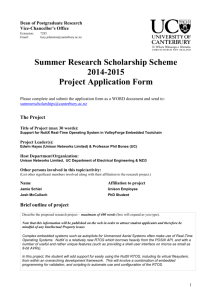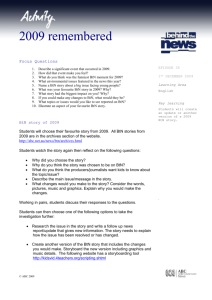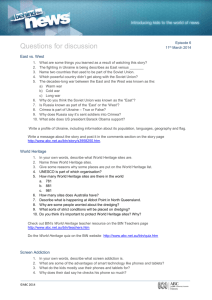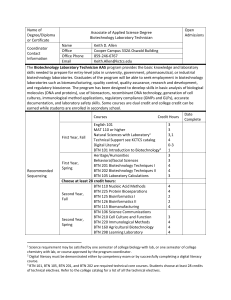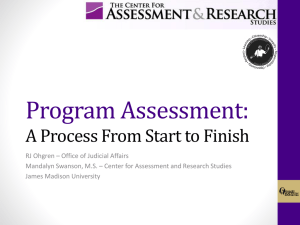L08-FSM
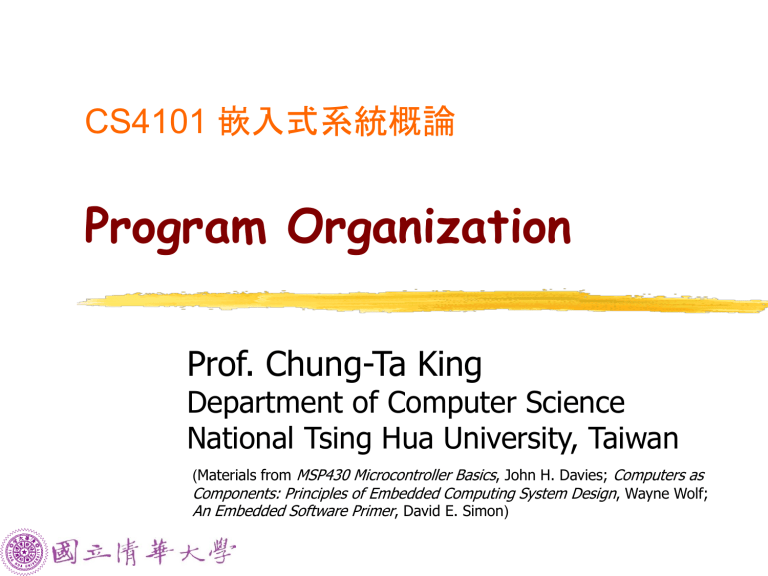
CS4101
嵌入式系統概論
Program Organization
Prof. Chung-Ta King
Department of Computer Science
National Tsing Hua University, Taiwan
(
Materials from MSP430 Microcontroller Basics , John H. Davies; Computers as
Components: Principles of Embedded Computing System Design , Wayne Wolf;
An Embedded Software Primer , David E. Simon
)
Outline
Embedded program design patterns
Embedded software architecture
1
Embedded Program Design Pattern
A design pattern is a generalized description of a certain type of programs that can be customized and used in different circumstances
Designer fills in details to customize the pattern to a particular programming problem
Help developers to identify essential elements of the system and facilitate the development of embedded software
Two patterns introduced here
Data stream pattern
State machine pattern
2
Data Stream Pattern
Commonly used in signal processing:
New data constantly arrives, e.g., from ADC
Each datum has a limited lifetime
Processing a datum requires previous data elements
Use a circular buffer to hold the data stream
shift window x1 x2 x3 x4 x5 x6 x1 x2 x3 x4 t
1 t
2 t
3
Data stream Circular buffer
3
Circular Buffer
Indexes locate currently used data, current input data: input use d1 d2 d3 d4 use input d5 d2 d3 d4 time t1 time t1+1
4
Example: FIR Filter
int circ_buffer[N], circ_buffer_head = 0; int c[N]; /* coefficients */
… int ibuf, ic; for (f=0, ibuff=circ_buff_head, ic=0; ic<N; ibuff=(ibuff==N-1?0:ibuff++), ic++) f = f + c[ic]*circ_buffer[ibuf];
5
State Machine Pattern
Identify states in the problems and describe the state transitions in a state machine
State machine keeps internal state as a state variable , changes state based on inputs and performs operations on state transitions
State machine is useful in many contexts:
Parsing user input
Responding to complex stimuli
Controlling sequential outputs
For control-dominated code, reactive systems
6
Recall Basic Lab of Lab 7
Flash green LED at 1 Hz using interrupt from
Timer_A, driven by SMCLK sourced by VLO.
While green LED flashing at 1 Hz, pushing the button flashes red LED at 2Hz and releasing the button turns off red LED. Use low-power mode as much as possible.
How do you organize your program?
If apply state machine pattern, how many states can you identify?
7
State Machine of Lab 7
no P1.3 in
P1.3 in/set red LED flashing, set P1.3 edge no P1.3 in
BTN_off
P1.3 in/reset red LED flashing, set P1.3 edge an event triggering interrupt
BTN_on works to do in ISR
Why don’t we consider the flashing green LED?
8
State Table of Lab 7
From the state machine, we can set up a state transition table with a column for the actions associated with each transition
Present state
Enable input
Next state
Actions no P1.3
BTN_off none
BTN_off
P1.3
BTN_on set red LED flashing, set P1.3 edge
BTN_on no P1.3
P.1.3
BTN_on
BTN_off none reset red LED flashing, set P1.3 edge
9
C Code Structure
Create a variable to record the state
State table can be implemented as a switch
Cases define states
States can test inputs, make state transitions, perform corresponding actions
Switch can be executed repetitively (polling) or invoked by interrupts (in ISR) switch (state) { case state1: … case state2: …
}
10
Outline
Embedded program design patterns
Embedded software architecture
11
Embedded Software Architecture
Basic architecture to put your code to run
Most important factor in choosing architecture:
How much control on system responses?
Depending on system requirements, costs, etc.
e.g., whether must respond rapidly to many different events and that has various processing requirements, with different deadlines and priorities, etc.
Four software architectures are introduce here
Round-robin, interrupt-driven, task queue, real-time operating system (RTOS)
12
Round-Robin
Check each event or I/O device in turn and service them as needed
A C code written for it would consist of a switch-case loop that performs functions based on the detected events
13
Round-Robin
Simplest architecture without interrupts or shared-data concerns no priority, no preemption, no control of responses
Problems:
When a device needs response in less time than it takes the CPU to loop through in the worst case, e.g., device Z needs <7 ms to respond, but A and B take 5 ms each to process
When a device needs lengthy processing worst case response time will be as bad as that
Architecture is not robust addition of a single device might cause all deadlines to be missed
14
Interrupt-Driven
Events trigger interrupts, which perform corresponding actions in ISRs
Most of our labs use this architecture
When there is no event to handle, main function goes into low power modes
Characteristics:
If no interrupt allowed inside an interrupt
non-preemptive
Execution order depends on the order and/or priority of interrupts (not fixed as in round-robin)
limited control of responses
15
Task Queue
All the labs we have studied so far perform very simple work on interrupts.
In practice, an event may trigger complex computations, which may not be suitable for processing within ISRs.
Example: Need to handle button events while in the middle of sending a byte to the PC using software
UART. If the button event requires more time to process than the duration of transmitting a single bit, we may miss the deadline to transmit the next bit.
Solution: move non-critical works out of ISR
16
Task Queue
Interrupts for checking events and urgent works and main loop proceeds with follow-up works
ISRs put action requests in some priority queue, and main function picks next task from queue for works
#pragma vector=EVENTA_VECTOR
__interrupt void EventA_ISR(void) {
// put event A request in queue } void main (void) { while (TRUE) {
// pick next request from queue
// process corresponding actions }
}
17
Task Queue
More control over priorities and better response
Events can be assigned priorities, giving better responses especially for devices with hard deadlines
Disadvantage:
Complexity of working with shared-data variables
Limited task scheduling capability and handle scheduling in application
need to wait till current action done before next scheduling
Difficult to implement preemptions of low-priority tasks
18
Real-Time Operating System
Task code is separated into threads
ISRs handle important works and request corresponding threads be scheduled
RTOS will decide which thread to run based on urgency (priority)
RTOS can suspend a thread to run another (usually higher priority) one
Response is independent of task code length
Changes to code lengths of low priority tasks don’t affect higher priority tasks.
19
Selecting an Architecture
Select the simplest architecture meeting response requirements.
RTOSs should be used where response requirements demand them.
Hybrid architectures can be used if required. e.g. you can use an RTOS with a low-priority task polling the relatively slower hardware.
20

